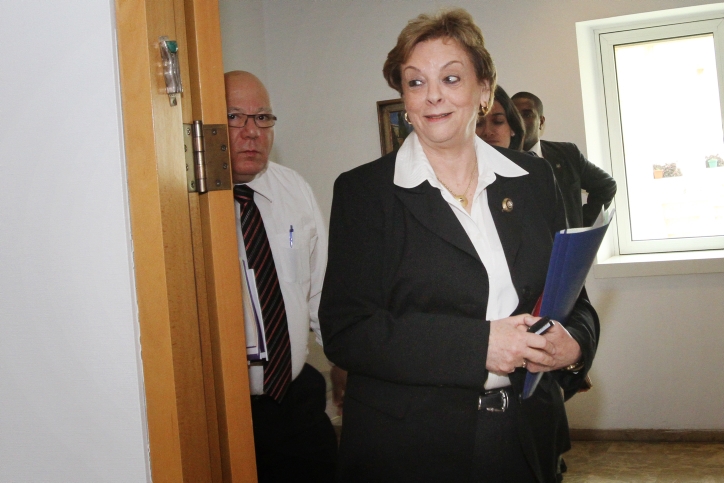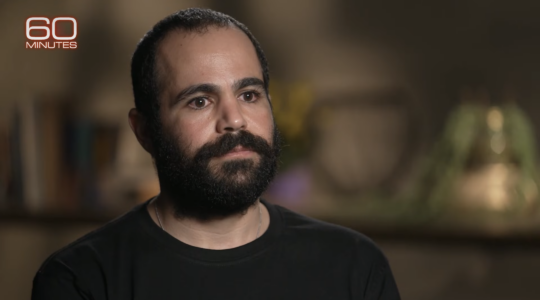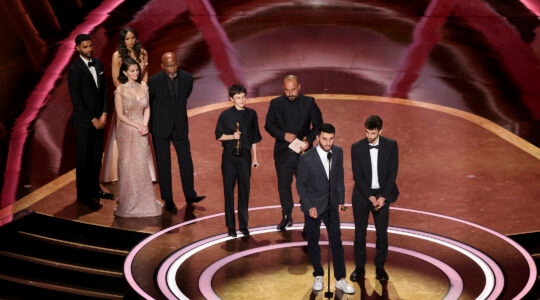JERUSALEM (JTA) — It ordered the West Bank security fence rerouted because it cut through private Palestinian property.
It overturned state-backed discrimination against Arab Israelis on issues of land distribution and ruled against the Israel Defense Forces’ use of military methods deemed to cause “disproportionate” harm to Palestinian civilians. It overturned Israel’s ban against political parties said to be too “radical.”
And just last week it ruled that the Tal Law, which grants exemptions to haredi Orthodox Israelis from Israel’s military draft so they can study in yeshiva, is unconstitutional.
These are just some of the Israeli Supreme Court decisions that have changed the way Israel does business during the tenure of justice Dorit Beinisch, Israel’s first female chief of the court.
The Supreme Court’s interventionist approach — with its strong emphasis on protecting minority rights – was pioneered by Aharon Barak, who served as the court’s president (the Israeli equivalent to chief justice) between 1995 and 2006. But Beinisch, who is retiring from the court this week after serving since December 1995, upheld the tradition of judicial activism, keeping the court at the center of Israeli public debate and making it a lightning rod for Orthodox and right-wing critics.
That could change as Beinisch, who turned 70 on Tuesday, steps down and is replaced by Asher Grunis, a conservative justice who has made a name for himself as a supporter of judicial restraint.
“There is a huge difference between Grunis’ approach and that of Barak and Beinisch,” said Barak Medina, dean of Hebrew University’s law department. “If the Supreme Court were to move in Grunis’ direction, it would be a 180-degree turnaround.”
In recent months, critics of the court have stepped up their efforts to curtail the court’s power. Lawmakers from the Likud and Yisrael Beiteinu parties — supported by Justice Minister Ya’acov Ne’eman, a critic of judicial activism — have recommended a slew of reforms aimed at changing the way justices are appointed. Perhaps the most far-reaching proposal is to take away the court’s veto over justice appointments and give all the power over appointments to the Knesset.
Israel’s highest court has 15 members, though only some of the judges are assigned to each case.
Critics of the court argue that the present system for selecting justices results in a court comprised largely of like-minded figures who seek the appointment only of those who share their ideological agenda, which they charge is pro-human rights and left wing.
The court’s defenders say that in Israel’s fractious society, where the Knesset frequently shirks its responsibility to protect religious pluralism, civil liberties and the rights of Palestinians, the court has no choice but to fill the moral and legal vacuum. Maintaining an independent judiciary, they say, serves as a counterweight against the danger that a “tyranny of the majority” tramples the rights of those who are not properly represented by the political system. Increasing politicians’ role in choosing judicial nominees would destroy a necessary balance of powers.
Though its critics accuse the court of ideological bias, the court’s rulings are far from one-sided.
In December, for instance, the court rejected a petition by the Israeli human rights NGO Yesh Gvul against Israeli quarries operating in the West Bank, which the Palestinians claim as their future state. And in January, the court upheld the Citizenship and Entry Law, which severely restricts the right of Palestinians married to Israelis to receive Israeli citizenship.
So far, none of the reformist motions have passed, and Israeli Prime Minister Benjamin Netanyahu has sided with the more liberal-minded members of his party — ministers Dan Meridor and Benny Begin — against the court’s opponents within his own party and beyond.
But with Beinisch stepping down, change could come through an evolutionary process that might bring about a conservative shift in Israel’s supreme arbitrator of justice.
Grunis’ support for judicial restraint was demonstrated in a recent Supreme Court ruling that rejected extension of the Tal Law, which was passed in 2002. Grunis was the only justice on the expanded nine-person panel who argued on principle that the court should not interfere with an issue best left up to lawmakers (though two additional justices opposed intervention for other reasons).
Grunis and other more conservative-minded jurists have argued that too much judicial activism involves the court in controversy and increases the chances that justices will appear politically partial, which can lead to a deterioration of the court’s strength and legitimacy.
By contrast Beinisch, who has served as the court’s president since September 2006, was among the six justices who ruled that the Tal Law was “unconstitutional” because it discriminated against Israelis who were drafted into the IDF. Israel lacks a formal constitution, but several Basic Laws, which protect human rights, have quasi-constitutional status in the eyes of the court.
While Grunis, 56, opposes Beinisch’s judicial activism and would like to reduce the number of petitions the court hears from parties that lack legal “standing” (i.e. are not personally affected), it is far from clear that Grunis will be able to transform the 15-member court.
“Grunis undoubtedly will be the first among equals,” said Aviad Hacohen, dean of the Sha’arei Mishpat Academic College in Hod HaSharon. “In theory he can pick more conservative justices to make up the panels that rule on sensitive cases, but he might draw fire from critics. Also, there is a tradition that the most senior justices preside over the most difficult or sensitive cases, regardless of their ideological leaning.”
Even if Grunis manages to introduce more judicial restraint to the court, which he has served on since 2003, some legislators say they will not be satisfied until more drastic reforms are implemented.
“Grunis’ appointment goes some way toward fixing an injustice,” said Yariv Levin, a Likud Knesset member who is spearheading the Supreme Court reform campaign. “But it will be impossible to bring about a real change as long as Supreme Court justices are chosen the way they are.”
Justices are chosen through a nine-member Judges Selection Committee that is chaired by the justice minister and comprised of one Cabinet member, three sitting justices including the president, two Bar Association delegates — who have tended to share the judicial activist ideology of the justices — and two Knesset members.
“Lawmakers pushing for a change in the appointment process do not just want to curb judicial activism,” Medina said. “They want to free themselves of the constraints of liberal democracy and human rights as championed by the Supreme Court.”
Likud’s Levin says he would like to see more consideration given in Supreme Court rulings to the fact that Israel is a Jewish state and less weight to the promotion of universalistic values such as human rights.
“I have no illusions that this process will take time,” Levin said. “It might not happen in this government. But if present trends continue, in the next elections the right will become even stronger while the opposition will be weakened. The democratically elected Knesset will be the one that will choose Supreme Court Justices in an open, transparent process. And these justices will hold opinions that more accurately reflect those of the majority.”
JTA has documented Jewish history in real-time for over a century. Keep our journalism strong by joining us in supporting independent, award-winning reporting.






